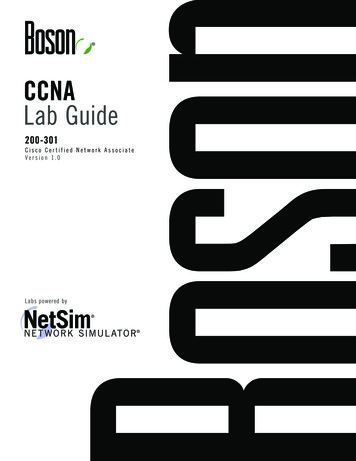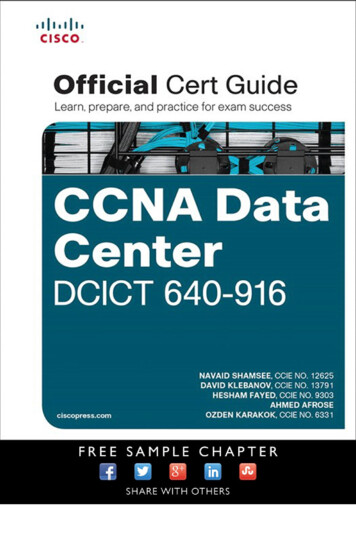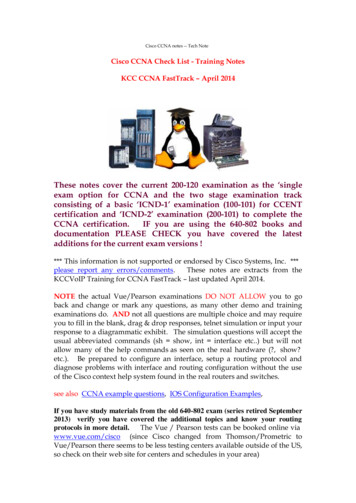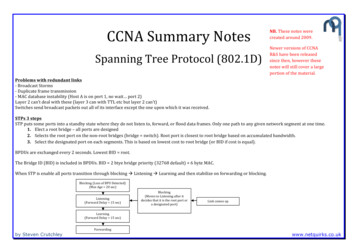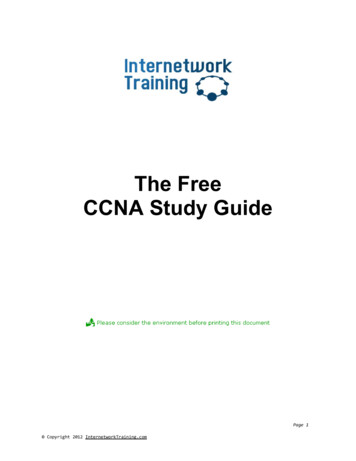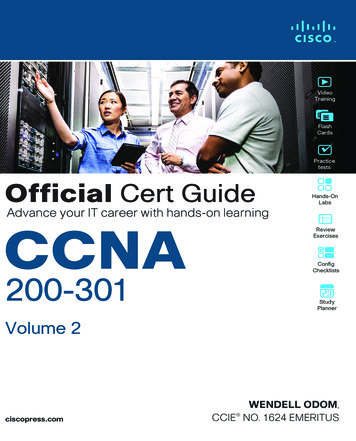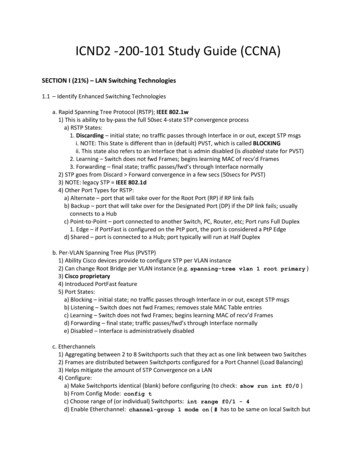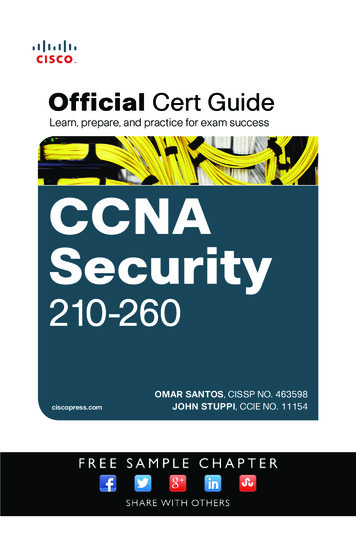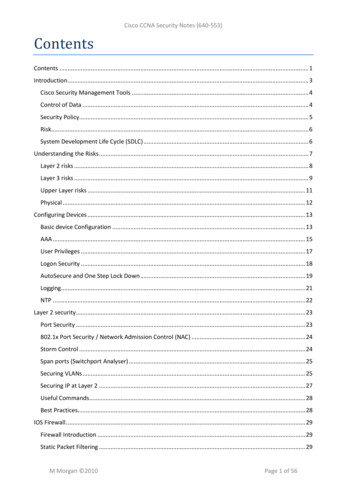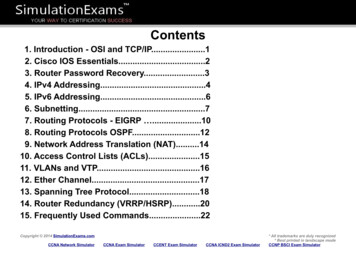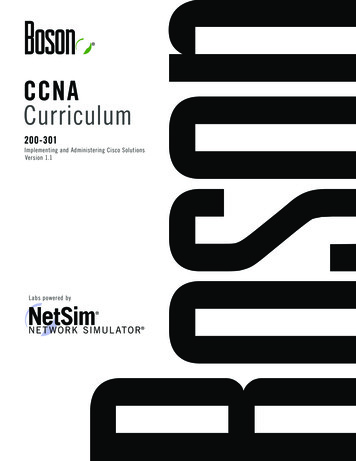
Transcription
CCNACurriculum200-301Implementing and Administering Cisco SolutionsVersion 1.1Labs powered by
Cisco Certified NetworkAssociate200-301 CurriculumLM20200828/BV1.0 2020 Boson Software, LLC iii
2 5 C e n t u r y B l v d . , S t e . 5 0 0 , N a s h v i l l e , T N 3 7 2 14 B o s o n . c o mThe labs referenced in this book have been printed in the Boson Lab Guide, which is included with thepurchase of the curriculum. These labs can be performed with real Cisco hardware or in the Boson NetSimNetwork Simulator version 11 or later. To learn more about the benefits of using NetSim or to purchase thesoftware, please visit www.boson.com/netsim.Copyright 2020 Boson Software, LLC. All rights reserved. Boson, Boson NetSim, Boson NetworkSimulator, and Boson Software are trademarks or registered trademarks of Boson Software, LLC. Catalyst,Cisco, and Cisco IOS are trademarks or registered trademarks of Cisco Systems, Inc. Puppet is a trademarkor registered trademark of Puppet, Inc. and is used with permission. No endorsement by Puppet, Inc. isimplied by the use of these marks. Ansible is a registered trademark of Red Hat, Inc. in the United Statesand other countries. Chef is a registered trademark of Chef, Inc. Media elements, including images and clipart, are available in the public domain. All other trademarks and/or registered trademarks are the propertyof their respective owners. Any use of a third-party trademark does not constitute a challenge to said mark.Any use of a product name or company name herein does not imply any sponsorship of, recommendation of,endorsement of, or affiliation with Boson, its licensors, licensees, partners, affiliates, and/or publishers.iv 2020 Boson Software, LLC
CCNA Curriculum Table of ContentsModule 1: Network Fundamentals.19Overview. 20Objectives. 20The OSI Model. 21Application Layer. 22Presentation Layer. 23Session Layer. 24Transport Layer. 25Network Layer. 26Data Link Layer. 27Physical Layer. 28Network Devices. 29Hubs. 30Bridges. 31Switches. 32Routers. 33Servers. 34Endpoints. 35Next-Generation Firewalls and IPS Devices. 36WAPs. 37Controllers. 38Cisco Three-Tier Network Design Model. 39Core Layer. 40Distribution Layer.41Access Layer. 42Cisco Two-Tier Network Design Model. 43Spine-Leaf Topology. 44WAN Topologies. 45SOHO Topologies. 46On-Premises and Cloud Deployments. 47SaaS. 48PaaS. 49IaaS. 50Interfaces and Cabling.51Copper Cables. 52Connecting UTP With RJ-45. 53Understanding Straight-Through and Crossover Cables. 56Serial Cables. 57Fiber-Optic Cables. 58Fiber-Optic Cable Types. 59Fiber-Optic Cable Connectors. 60PoE. 61Troubleshooting Interfaces and Cabling. 63 2020 Boson Software, LLCv
CCNA Curriculum Table of ContentsExcessive Noise. 64Collisions. 66Late Collisions. 68Duplex Mismatch. 70Speed Mismatch. 72Using the OSI Model to Troubleshoot Networks.74Understanding the Bottom Up Troubleshooting Technique.74Understanding the Top Down Troubleshooting Technique.74Understanding the Divide and Conquer Troubleshooting Technique. 75Troubleshooting Connectivity. 76Troubleshooting Physical Layer Connectivity. 77Troubleshooting Data Link Layer Connectivity. 79Troubleshooting Network Layer Connectivity. 80Summary. 81Review Question 1. 83Review Question 2. 85Review Question 3. 87Module 2: Network Addressing and Transport.89Content in these modules is available in the full version of thecurriculum. Please visit www.boson.com for more information.Overview. 90Objectives. 90Layer 2 Addressing. 91Ethernet Overview. 92Ethernet Frames. 93MAC Address. 94Layer 3 Addressing. 96IPv4 Overview. 97Binary Overview . 99Dotted Decimal Overview . 100Converting from Binary to Decimal . 101Converting from Decimal to Binary . 103Classful Networks . 106Classless Networks . 108Subnetting.110Subnetting and Route Summarization.112Automatic IP Address Configuration.113Understanding the Differences Between IPv4 and IPv6.114Understanding the Differences Between IPv4 and IPv6 Headers.115Understanding IPv6 Address Composition.117Abbreviating IPv6 Addresses.118Understanding IPv6 Address Prefixes. 120Understanding IPv6 Address Types.121Understanding Global Unicast Addresses and Route Aggregation. 124vi 2020 Boson Software, LLC
CCNA Curriculum Table of ContentsUnderstanding EUI-64 Interface IDs. 126Understanding Stateful and Stateless Address Configuration. 127Using IPv6 in an IPv4 World. 128Dual Stack. 129Network Address Translation-Protocol Translation. 130Tunneling.131Verifying Layer 3 Addressing on Clients. 133Verifying Layer 3 Addressing on Windows Clients. 134Verifying Layer 3 Addressing on Linux Clients. 135Verifying Layer 3 Addressing on Mac OS X Clients. 136Layer 4 Addressing.137UDP. 138TCP. 140Summary.142Review Question 1. 143Review Question 2. 145Review Question 3.147Review Question 4. 149Lab Exercises.151Content in these modules is available in the full version of theModule3: Wireless NetworkingFundamentals.153curriculum.Please visitwww.boson.com for more information.Overview. 154Objectives. 154Radio Frequency. 155WLAN Topologies. 156IBSS. 157BSS. 158ESS. 159Wireless Bands and Channels. 160Wireless Standards. 163Associating With an AP. 165Open Authentication and WEP. 166WPA. 167WPA2. 168WPA3. 169802.1x.170802.11 MAC Frames.171Summary.173Review Question 1.175Review Question 2. 177Review Question 3.
Curriculum 200-301 CCNA Implementing and
